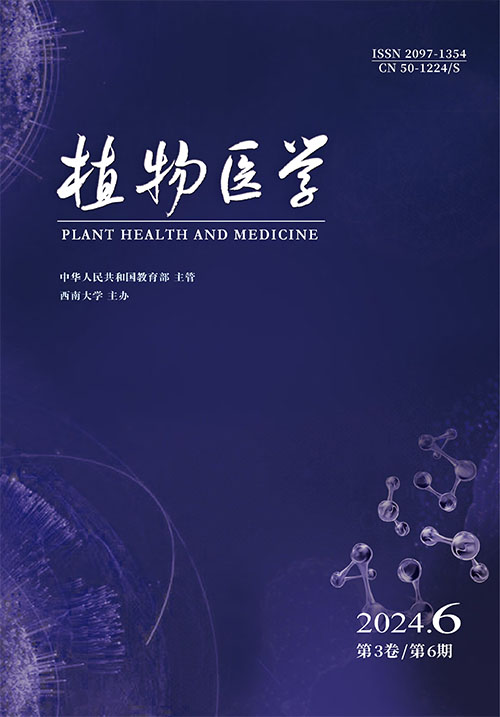|
[1]
|
MAAYER P. Genome Comparisons to Identify Selected Pathogenicity Factors of a Plant-Associated PantoeaAnanatis Strain[Z]. University of Pretoria, 2011.
Google Scholar
|
|
[2]
|
CHAKRABORTY S, NEWTON A C. Climate Change, Plant Diseases and Food Security:an Overview[J]. Plant Pathology, 2011, 60(1):2-14.
Google Scholar
|
|
[3]
|
GEVAO B, SEMPLE K T, JONES K C. Bound Pesticide Residues in Soils:a Review[J]. Environmental Pollution, 2000, 108(1):3-14.
Google Scholar
|
|
[4]
|
SILVA V, MOL H G J, ZOMER P, et al. Pesticide Residues in European Agricultural Soils-a Hidden Reality Unfolded[J]. Science of the Total Environment, 2019, 653:1532-1545.
Google Scholar
|
|
[5]
|
TANG W X, WANG D, WANG J Q, et al. Pyrethroid Pesticide Residues in the Global Environment:an Overview[J]. Chemosphere, 2018, 191:990-1007.
Google Scholar
|
|
[6]
|
PANDEY N, ADHIKHARI M, BHANTANA B. Trichoderma and Its Prospects in Agriculture of Nepal:an Overview[J]. International Journal of Applied Sciences and Biotechnology, 2019, 7(3):309-316.
Google Scholar
|
|
[7]
|
MAJEED A. Application of Agrochemicals in Agriculture:Benefits, Risks and Responsibility of Stakeholders[J]. Journal of food science and toxicology, 2018.
Google Scholar
|
|
[8]
|
LONE M Y, BABA B A, RAJ P, et al. Haematological and Hepatopathological Changes Induced by Dimethoate in Rattus Rattus[J]. Indo American Journal of Pharmaceutical Research, 2013.
Google Scholar
|
|
[9]
|
XIA Y Y, HUANG G, ZHU Y X. Sustainable Plant Disease Control:Biotic Information Flow and Behavior Manipulation[J]. Science China Life Sciences, 2019, 62(12):1710-1713.
Google Scholar
|
|
[10]
|
RANGASAMY K, ATHIAPPAN M, DEVARAJAN N, et al. Emergence of Multi Drug Resistance among Soil Bacteria Exposing to Insecticides[J]. Microbial Pathogenesis, 2017, 105:153-165.
Google Scholar
|
|
[11]
|
GRESSEL J. Microbiome Facilitated Pest Resistance:Potential Problems and Uses[J]. Pest Management Science, 2018, 74(3):511-515.
Google Scholar
|
|
[12]
|
MWATAWALA M, YEYEYE G E. Education, Training and Awareness of Laws as Determinants of Compliance with Plant Protection Law:The Case of Pest Icide Use Practices in Tanzania[J]. African Journal of Food, Agriculture, Nutrition and Development, 2016, 16(1):10686-10700.
Google Scholar
|
|
[13]
|
DIARRA A, HAGGBLADE S. Regulatory Challenges in West Africa:Instituting Regional Pesticide Regulations during a Period of Rapid Market Growth[Z]. 2017.
Google Scholar
|
|
[14]
|
YANGA N, WOFFORD P, DEMARS C, et al. Pesticide Use Reporting Data in Pesticide Regulation and Policy:The California Experience[M]//ACS Symposium Series. Washington, DC:American Chemical Society, 2018:97-114.
Google Scholar
|
|
[15]
|
SAJEENA A, JOHN J, SUDHA B, et al. Significance of Botanicals for the Management of Plant Diseases Plant Health Under Biotic Stress, 2019:231-243.
Google Scholar
|
|
[16]
|
CHOUDHURY D, DOBHAL P, SRIVASTAVA S, et al. Role of Botanical Plant Extracts to Control Plant Pathogens[J]. Indian Journal of Agricultural Research, 2018, 52(4):341-346..
Google Scholar
|
|
[17]
|
YOON M Y, CHA B, KIM J C. Recent Trends in Studies on Botanical Fungicides in Agriculture[J]. The Plant Pathology Journal, 2013, 29(1):1-9.
Google Scholar
|
|
[18]
|
SHUPING D S S, ELOFF J N. The Use of Plants to Protect Plants and Food Against Fungal Pathogens:a Review[J]. African Journal of Traditional, Complementary and Alternative Medicines:AJTCAM, 2017, 14(4):120-127.
Google Scholar
|
|
[19]
|
MAHLO S M, CHAUKE H R, MCGAW L, et al. Antioxidant and Antifungal Activity of Selected Medicinal Plant Extracts Against Phytopathogenic Fungi[J]. African Journal of Traditional, Complementary and Alternative Medicines:AJTCAM, 2016, 13(4):216-222.
Google Scholar
|
|
[20]
|
SALHI N, MOHAMMED SAGHIR S A, TERZI V, et al. Antifungal Activity of Aqueous Extracts of Some Dominant Algerian Medicinal Plants[J]. BioMed Research International, 2017, 2017:7526291.
Google Scholar
|
|
[21]
|
MAFAKHERI H, MIRGHAZANFARI S M. Antifungal Activity of the Essential Oils of some Medicinal Plants Against Human and Plant Fungal Pathogens[J]. Cellular and Molecular Biology (Noisy-Le-Grand, France), 2018, 64(15):13-19.
Google Scholar
|
|
[22]
|
MONGALO N I, DIKHOBA P M, SOYINGBE S O, et al. Antifungal, Anti-Oxidant Activity and Cytotoxicity of South African Medicinal Plants Against Mycotoxigenic Fungi[J]. Heliyon, 2018, 4(11):e00973.
Google Scholar
|
|
[23]
|
姚翰文, 葛康康, 潘佳亮, 等. 丁香等29种植物提取物抑菌活性的筛选[J]. 东北林业大学学报, 2017, 45(10):35-39.
Google Scholar
|
|
[24]
|
张兴, 马志卿, 冯俊涛, 等. 植物源农药研究进展[J]. 中国生物防治学报, 2015, 31(5):685-698.
Google Scholar
|
|
[25]
|
单体江, 张伟豪, 王松, 等. TLC-生物自显影检测26种植物中的抗细菌和抗氧化活性物质[J]. 植物保护, 2018, 44(6):66-72.
Google Scholar
|
|
[26]
|
LIN H C, KUO Y L, LEE W J, et al. Antidermatophytic Activity of Ethanolic Extract from Croton Tiglium[J]. BioMed Research International, 2016, 2016:3237586.
Google Scholar
|
|
[27]
|
TAO N G, JIA L, ZHOU H E. Anti-Fungal Activity of Citrus Reticulata Blanco Essential Oil Against Penicillium Italicum and Penicillium Digitatum[J]. Food Chemistry, 2014, 153:265-271.
Google Scholar
|
|
[28]
|
KHATTAK S, SAEED-UR-REHMAN, ULLAH SHAH H, et al. Biological Effects of Indigenous Medicinal Plants Curcuma Longa and Alpinia Galanga[J]. Fitoterapia, 2005, 76(2):254-257.
Google Scholar
|
|
[29]
|
CHO J Y, CHOI G J, LEE S W, et al. In Vivo Antifungal Activity Against Various Plant Pathogenic Fungi of Curcuminoids Isolated from the Rhizomes of Curcuma Longa[J]. The Plant Pathology Journal, 2006, 22(1):94-96.
Google Scholar
|
|
[30]
|
金磊, 方凌, 汪颖. 铜陵地区不同种类牡丹籽提取物抑菌性比较[J]. 食品工程, 2019(1):36-38.
Google Scholar
|
|
[31]
|
姜文洁. 不同栽培蓝莓品种抗氧化与抑菌功能的研究[D]. 上海:上海海洋大学, 2015.
Google Scholar
|
|
[32]
|
张传清, 章祖平, 孙品雷, 等. 山核桃干腐病菌对7种杀菌剂的敏感性比较及其对苯醚甲环唑敏感基线的建立[J]. 农药学学报, 2011, 13(1):84-86.
Google Scholar
|
|
[33]
|
龚双军, 杨立军, 向礼波, 等. 小麦白粉病菌对喹氧灵和苯菌酮的敏感基线及药剂的生物活性[J]. 农药学学报, 2013, 15(5):511-515.
Google Scholar
|
|
[34]
|
刘琼, 张新龙, 黄琦, 等. 茼蒿粗提物对西瓜枯萎病菌的抑菌活性[J]. 江西农业大学学报, 2015, 37(5):832-835.
Google Scholar
|
|
[35]
|
姜少娟, 陈豪, 李飞. 紫茎泽兰不同溶剂提取物的抑菌活性[J]. 江苏农业科学, 2013, 41(7):124-126.
Google Scholar
|
|
[36]
|
PARK S, RHU Y H, BAE S G, et al. Screening of Antifungal Activities of Plant Extracts Against Phytopathogenic fungi[J]. Korean Journal of Plant Resources, 2017, 30(4):343-351.
Google Scholar
|
|
[37]
|
胡定慧, 徐兴全, 王小松, 等. 苦参提取液对小麦条锈病菌的抑制作用[J]. 江苏农业科学, 2008, 36(6):120-122.
Google Scholar
|
|
[38]
|
程小梅, 彭亚军, 杨玉, 等. 猕猴桃青霉病病原菌鉴定及中草药提取物对其抑菌效果[J]. 植物保护, 2018, 44(3):186-189, 202.
Google Scholar
|
|
[39]
|
胡军华, 马丽娜, 贺磊, 等. 47种植物提取物对3种柑桔常见贮藏病害病原菌活性抑制作用研究[J]. 中国南方果树, 2010, 39(3):1-4, 8.
Google Scholar
|





 DownLoad:
DownLoad: